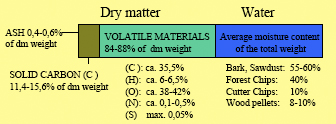General aspects of wood as a fuel
The characteristics affecting the properties of wood as a fuel are: heating value, chemical composition, moisture content, density, hardness, the amount of volatile matters, the amount of solid carbon, ash content and composition, the melting behaviour of ash, the slagging behaviour of ash and the amount of impurities, dust and fungi spores.
Wood fuel chips, for instance, are often made of various tree species with various proportions of wood, bark, foliage, branches, buds, and even cones. This causes variation in the fuel properties.
Approximately one half of fresh, just fallen tree is water. The other half consists of dry matter of wood, approximately 85% of which consists of volatile matters, 14,5% of solid carbon and 0,5% of ash. When wood is combusted, its components will change into steam of water (H2O), carbon dioxide (CO2), nitrogen oxides (NO2), sulphur oxides (SO2) and ash. Wood has practically no sulphur at all, as its share in wood is 0,05% at the highest. The average chemical content of wood fuels is shown in Table 1.
Table 1: The average chemical content of wood fuels

